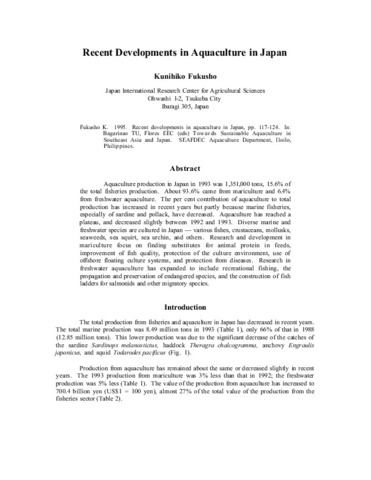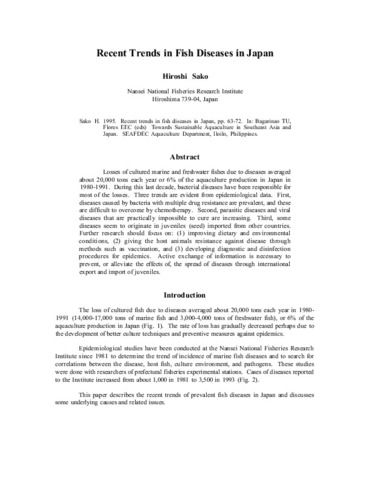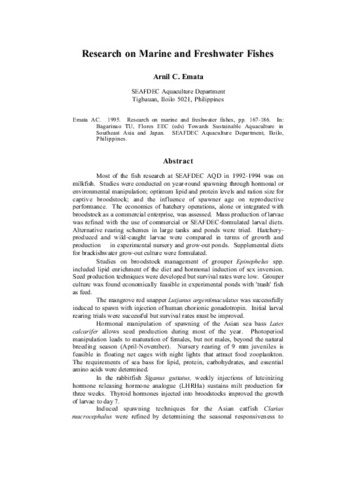Browsing ADSEA '94 by Title
Now showing items 11-21 of 21
-
Recent developments in aquaculture in Japan
(Aquaculture Department, Southeast Asian Fisheries Development Center, 1995)Aquaculture production in Japan in 1993 was 1,351,000 tons, 15.6% of the total fisheries production. About 93.6% came from mariculture and 6.4% from freshwater aquaculture. The per cent contribution of aquaculture to total ... -
Recent trends in fish diseases in Japan
(Aquaculture Department, Southeast Asian Fisheries Development Center, 1995)Losses of cultured marine and freshwater fishes due to diseases averaged about 20,000 tons each year or 6% of the aquaculture production in Japan in 1980-1991. During this last decade, bacterial diseases have been responsible ... -
Recommendations for responsible aquaculture
(Aquaculture Department, Southeast Asian Fisheries Development Center, 1995)Aquaculture has grown rapidly in Asia. In 1992, out of the 52.8 million tons of total production of aquatic organisms, as much as 17 million tons (32.2%) came from aquaculture. However, unplanned and uncontrolled development ... -
Research on crustaceans
(Aquaculture Department, Southeast Asian Fisheries Development Center, 1995)Crustacean research at the SEAFDEC Aquaculture Department during the last three years focused mostly on the tiger shrimp Penaeus monodon. Studies were done along six problem areas: (1) developing spawning techniques for ... -
Research on marine and freshwater fishes
(Aquaculture Department, Southeast Asian Fisheries Development Center, 1995)Most of the fish research at SEAFDEC AQD in 1992-1994 was on milkfish. Studies were conducted on year-round spawning through hormonal or environmental manipulation; optimum lipid and protein levels and ration size for ... -
Research on seaweeds and mollusks
(Aquaculture Department, Southeast Asian Fisheries Development Center, 1995)Research on seaweeds focused on the carrageenan-producing Kappaphycus alvarezii and the agar-producing Gracilaria spp. Growth of K. alvarezii was better on horizontal lines than on vertical or cluster lines from bamboo ... -
The SEAFDEC Aquaculture Department at 21: R&D for sustainable aquaculture
(Aquaculture Department, Southeast Asian Fisheries Development Center, 1995)This paper reviews the research output of the SEAFDEC Aquaculture Department (AQD) over the past 21 years of its existence. These realized studies are compared with the priority problem areas recommended for research by ... -
Shrimp culture and the environment
(Aquaculture Department, Southeast Asian Fisheries Development Center, 1995)This paper reviews the interactions between shrimp culture and the natural environment. It considers and gives details of the effects of shrimp culture on the environment and the effects of environmental change on shrimp ... -
Towards sustainable aquaculture in Southeast Asia and Japan : proceedings of the Seminar-Workshop on Aquaculture Development in Southeast Asia, Iloilo City, Philippines, 26-28 July 1994
(Aquaculture Department, Southeast Asian Fisheries Development Center, 1995)Documents the presentations at ADSEA '94, the 3rd Seminar-Workshop on Aquaculture Development in Southeast Asia. ADSEA '94 includes reviews of the status of aquaculture development in Southeast Asia and Japan and of the ... -
Training and information dissemination at SEAFDEC AQD
(Aquaculture Department, Southeast Asian Fisheries Development Center, 1995)The SEAFDEC Aquaculture Department (AQD) is mandated to develop human resources and to disseminate and exchange information for aquaculture development in the region. In 1991-1994, a total of 294 participants attended 23 ... -
Transgenic fish and aquaculture
(Aquaculture Department, Southeast Asian Fisheries Development Center, 1995)Transgenic fish species can be routinely produced by transferring foreign DNA into developing embryos via microinjection or electroporation. This technology offers an excellent opportunity for modifying or improving the ...












